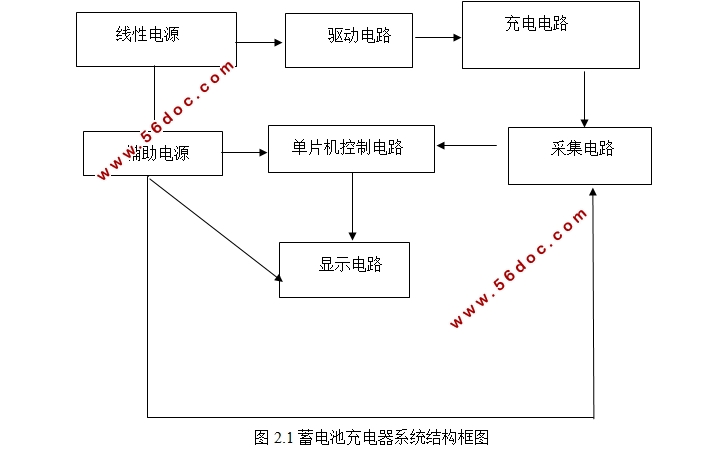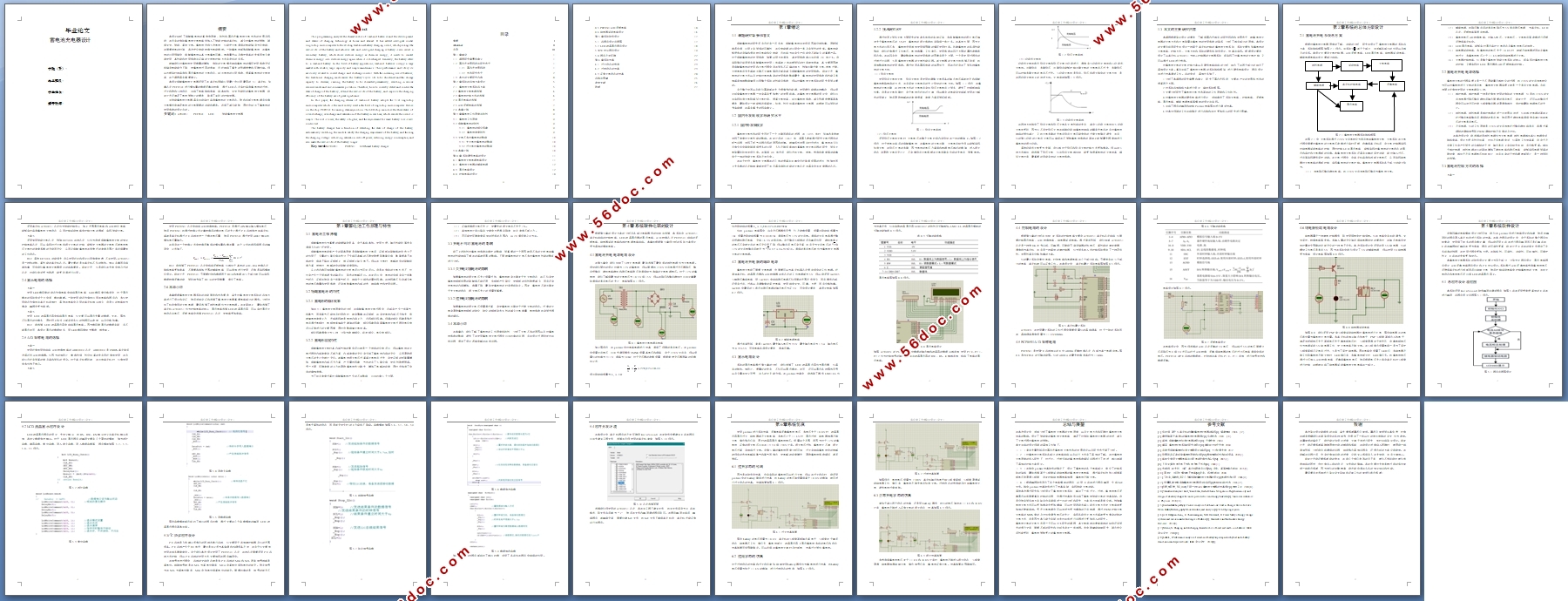蓄电池充电器设计(任务书,开题报告,论文12000字)
摘要
本设计剖析了铅酸蓄电池的重带你原理、特性和国内外蓄电池充电技术的发展及现状,在已有的传统蓄电池充电电路中加入了智能控制的单片机,减少对蓄电池的损耗,做到安全、智能、高效充电。蓄电池也称二次电池,它能把充电得到的电能储存为化学能;在需要放电的时候,再次把化学能转换为电能释放。一般蓄电池都指铅酸蓄电池,在蓄电池的应用领域中,铅酸蓄电池以其充电蓄电可靠、电容量大以及维护简单的优势而被人普遍使用,其性能和使用寿命与正确的充放电控制方式有密切的关系。
随着我们对蓄电池使用数量的增加,传统的充电模式造成蓄电池的循环使用寿命变短和储存电能能力下降,使蓄电池过早的废弃,已经造成了重大的资源浪费和环境污染。所以怎样实时地监测和显示蓄电池的充电状态、延长电池的应用寿命、提高蓄电池的充电效率,这个课题具有重要意义。
本设计铅酸蓄电池充电器采用了在单片机领域应用最广也应用最早的 51 单片机,依靠芯片PCF8591进行模拟量的数据采集与转换,通过LCD芯片实时监测蓄电池的过放、过充和饱和三种状态,完成了电路结构简单,成本较低,安全性能好的蓄电池充电器,除此之外还满足了电池损耗小的要求,取得了良好的控制效果。
该智能蓄电池充电器具有自动实时监测蓄电池的充电状态、饱和切断充电电源且切换充电模式来满足电池的充电需要的功能和要求。达到了减少能耗,同时也延长了蓄电池的使用寿命的设计目的。
关键词:AT89C51 PCF8591 LCD 智能蓄电池充电器
Abstract
This programming analyzes the characteristics of lead-acid batteries and the development and status of charging technology at home and abroad. It has added intelligent control single-chip microcomputer to the existing traditional battery charging circuit, which prolongs the service life of the battery and achieves safe and intelligent charging.A battery is also called a secondary battery, which stores electrical energy as chemical energy; it needs to convert chemical energy into electrical energy again when it is discharged. Generally, the battery refers to a lead-acid battery. In the field of battery applications, lead-acid batteries occupy a large market with reliable, large capacity and simple maintenance. Their performance and life cycle are closely related to correct charge and discharge control. With the increasing use of batteries, the traditional charging mode causes the battery's cycle life to be shortened and the storage capacity to decrease, causing the battery to be discarded prematurely, resulting in serious resource waste and environmental pollution. Therefore, how to correctly detect and control the state of charge of the battery, extend the service life of the battery, and improve the charging efficiency of the battery are of great significance.
In this paper, the charging scheme of lead-acid battery adopts the 51st single-chip microcomputer which is the most widely used in the field of single-chip microcomputer. It relies on the chip PCF8591 for analog data acquisition. The LCD chip monitors the three states of over-discharge, over-charge and saturation of the battery in real time, which realizes the circuit is simple. The cost is lower, the safety is higher, and the requirement for small battery loss is well controlled.
The battery charger has a function of detecting the state of charge of the battery, automatically switching the mode to satisfy the charging requirement of the battery, and showing the charging voltage. Achieving saturation cuts off power, reducing energy consumption, and also make the service life of the battery longer.
Key words:AT89C51 PCF8591 LCDSmart battery charger


目录
摘要 I
Abstract II
目录 III
第1章绪论 1
1.1 课题研究背景和意义 1
1.2 国内外发展现状与研究水平 1
1.2.1 国内外发展现状 1
1.2.2 技术研究水平 2
1.3 本文的主要研究内容 4
第2章系统的总体方案设计 5
2.1 蓄电池充电系统总方案 5
2.2蓄电池充电电源选择 6
2.3蓄电池控制方式的选择 6
2.4显示电路的选择 7
2.5 A/D采样电路的选择 7
2.6本章小结 8
第3章蓄电池工作原理与特性 9
3.1 蓄电池工作原理 9
3.2铅酸蓄电池的特性 9
3.2.1 蓄电池的极化现象 9
3.2.2 蓄电池温度特性 9
3.3充电不当对蓄电池的影响 10
3.3.1欠充电对蓄电池的影响 10
3.3.2过充电对蓄电池的影响 10
3.4本章小结 10
第4章.系统硬件电路的设计 11
4.1蓄电池充电电源电路设计 11
4.2 蓄电池充电器的辅助电源 12
4.3 显示电路设计 12
4.4 控制电路的设计 14
4.5 PCF8591A/D采样电路 14
4.6继电器驱动电路设计 16
第5章系统软件设计 17
5.1 总程序设计流程图 17
5.2 LCD液晶显示程序设计 18
5.3I2C协议程序设计 19
5.4程序开发环境 22
第6章系统仿真 23
6.1 过充状态的检测 23
6.2 过放状态的仿真 23
6.3正常充电状态的仿真 24
总结与展望 25
参考文献 26
致谢 27
|





